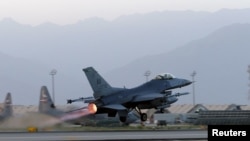The U.S. military says a new anti-Taliban air campaign has been expanded to northern Afghanistan near the border with China and Tajikistan to destroy insurgent revenue sources, training facilities and support networks.
The airstrikes began in November under President Donald Trump’s new Afghan war strategy and initially focused on Taliban-linked narcotics producing labs in the largest southern province of Helmand with a mission to cut insurgent main revenue streams.
“Over the past 96 hours, U.S. forces conducted air operations to strike Taliban training facilities in Badakhshan province, preventing the planning and rehearsal of terrorist acts near the border with China and Tajikistan,” the military announced Tuesday.
It added the strikes also destroyed stolen Afghan National Army vehicles that were in the process of being converted to vehicle-borne improvised explosive devices.
Afghan security forces, backed by U.S. and NATO partners, have maintained battlefield pressure on the Taliban throughout the winter in their bid to prevent insurgent regrouping and recuperating before fighting picks up in coming weeks.
This week’s U.S. airstrikes followed a series of pictures Taliban propagandists recently released via social media, showing insurgents winter training camps in snowy scenes. The group did not name the places but northern Afghan provinces, including Badakshan, are mostly covered with snow in winter months.
During these strikes, a U.S. Air Force B-52 Stratofortress dropped 24 precision guided weapons on Taliban fighting positions, setting a record of the most guided weapons ever released from the aircraft , the military said.
Meanwhile, the U.S. military said airstrikes in partnership with Afghan special forces have resulted in the removal of more than $30 million of Taliban revenue since the campaign began, according to Tuesday’s statement.
Most of the 14 districts in Helmand, one of the world’s major poppy producing region, are controlled or contested by the Taliban.
Afghan security forces, backed by U.S. and NATO partners, have maintained battlefield pressure on the Taliban throughout the winter in their bid to prevent insurgent regrouping and recuperating before fighting picks up in the coming weeks.
"The Taliban have nowhere to hide," said General John Nicholson, who commands U.S. and NATO’s Resolute Support mission in Afghanistan. "There will be no safe haven for any terrorist group bent on bringing harm and destruction to this country.”
Recent redeployment of a squadron of American A-10 ground attack planes in Afghanistan after a gap of three years, has also bolstered the air campaign.
On Monday, the U.S. military announced a batch of about 4,000 newly trained or under training Afghan commandos will be ready to join their national special forces by spring.
The boasting of military preparedness follows President Trump’s remarks last week in which he ruled out peace talks with the Taliban citing recent deadly attacks in Kabul and vowed to defeat the insurgents on the battlefield.
Over the weekend, Afghan President Ashraf Ghani also vowed not to engage in talks with Taliban groups who plotted the violence and promised to bring the perpetrators to justice.
The Taliban when asked for its reaction has refused to directly comment on Ghani’s remarks, mocking him as “merely an American puppet.”
The spokesman for the insurgency, Zabihullah Mujahid, however, reiterated while speaking to VOA the Taliban believes authority to decide on the fate of Afghan war rested with the U.S.
“President Trump has chosen the path of war and Mujahideen [Taliban fighters] are ready to deal with the challenge like they have successfully done in the past,” he asserted. Mujahid added the Taliban will not stop fighting until all foreign forces withdraw from the country.
Analysts say peace in Afghanistan has never been more elusive and the stepped up U.S. military operations coupled with an “emboldened and defiant Taliban" suggest the strong likely-hood of increased casualties in terms of Afghan civilians, security forces and foreign troops.
“I fear that this coming summer fighting season could be one of the bloodiest that Afghanistan has seen for quite some time,” cautioned Michael Kugelman, deputy director of the Asia Program at Washington’s Wilson Center.
He noted that U.S. policymakers hope the intensified military campaign will turn the tide of the war and weaken the Taliban significantly.
“Unfortunately, I think that the U.S. is banking on a misguided hope. If the U.S. couldn’t turn the tide of the war back in 2010 and 2011, when it had more than 100,000 troops in place, I can’t imagine it doing so now with less than 15,000 troops on the ground,” said Kugelman.
The Taliban controls or contests about 44 percent of Afghan territory, according to latest U.S. military assessments. The insurgent group inflicted heavy casualties on Afghan forces in 2017.
As many as 10,000 Afghan forces were killed last year, according to a recent New York Times article. The Afghan Defense Ministry has recently bared U.S. partners from making public details on casualties, attrition rate and other internal challenges facing Afghan security forces.
The United Nations also documented record levels of civilian casualties in 2017.
Conflict-related violence across Afghanistan last month reportedly caused more than 2,000 casualties, including nearly 1,200 fatalities. The Afghan news agency, Pajhwok, documented the casualties in an article published Monday, saying they included militant losses as well.













